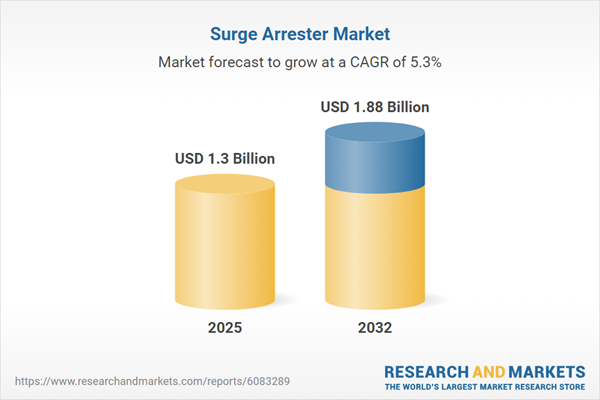Speak directly to the analyst to clarify any post sales queries you may have.
The surge arrester market is experiencing robust advancement as power networks modernize and integrate new energy sources. This evolution, driven by digitalization and sustainability priorities, positions surge protection as a critical focus area for senior stakeholders seeking operational resilience and optimized asset management.
Market Snapshot: Surge Arrester Market Size and Growth
The Surge Arrester Market grew from USD 1.24 billion in 2024 to USD 1.30 billion in 2025. It is projected to grow at a CAGR of 5.34%, reaching USD 1.88 billion by 2032. This growth trajectory reflects the increasing importance of advanced protection solutions amid grid complexity, renewable energy deployment, and stringent regulatory drivers globally.
Scope & Segmentation
This analysis provides a comprehensive review of the surge arrester market’s structure, with an emphasis on solutions, voltage levels, deployment environments, and regional landscapes. Primary segmentation elements include:
- Product Type: Metal oxide and silicon carbide arresters, each with distinct performance characteristics.
- Voltage Rating: Categories include high, medium, and low voltage options, designed for varied applications from transmission to commercial use.
- End User: Commercial (buildings, IT and telecom), industrial (manufacturing, mining, oil & gas), and utility (distribution, generation, transmission) sectors.
- Application: Renewable energy (hydro, solar, wind), telecommunications (broadband, wireless), and transmission & distribution assets (overhead lines, substations, underground cables).
- Installation Type: Indoor and outdoor setups, tailored for different operational conditions.
- Mounting Type: Pole mounted and wall mounted configurations for adaptive deployment.
- Distribution Channel: Direct, distributor, and online sales approaches for efficient market access.
- Regional Coverage: Americas (North America, Latin America), Europe, Middle East & Africa (Europe, Middle East, Africa), and Asia-Pacific (China, India, Japan, Australia, and additional key economies).
This segmentation ensures that market insights address the varied requirements and operational environments facing diverse industry stakeholders.
Key Takeaways for Senior Decision-Makers
- Grid modernization and renewable integration are driving demand for advanced surge protection that meets evolving performance and compliance criteria.
- Digitalization and the adoption of predictive analytics are supporting proactive asset management and reducing unplanned downtime across high-value infrastructure.
- Material innovation, particularly the uptake of silicon carbide in harsh or space-constrained installations, is reshaping product strategies and investment focus.
- Manufacturers are strengthening resilience by investing in R&D, vertical integration, and collaborative ventures, enhancing their ability to address supply chain volatility.
- Regional variances are shaping product design and deployment, with Western Europe, North America, and Asia-Pacific each presenting unique infrastructure priorities and competitive landscapes.
Tariff Impact on Supply Chains and Procurement Strategy
Recent tariff adjustments in the United States have significantly influenced the cost structures and sourcing practices for surge arrester manufacturers, especially regarding metal oxide and silicon carbide components. These changes have led to adjustments in supplier selection, more localized production, and a push towards modular product designs to insulate against price fluctuations. End users increasingly prioritize solutions that offer long service life and integrated monitoring to counterbalance higher initial investments induced by new trade policies.
Methodology & Data Sources
The research methodology for this report combines primary interviews with industry executives, engineers, and procurement specialists, supplemented by secondary reviews of technical publications, patent data, regulatory documents, and company disclosures. Rigorous data triangulation and peer review procedures ensure that the findings are accurate, reliable, and fully aligned with current market dynamics.
Why This Report Matters
- Delivers actionable insights for navigating regulatory shifts and technological advancements in surge protection.
- Equips senior leaders with a strategic framework for investment and operational decision-making across diverse end markets and regions.
- Supports risk mitigation and performance optimization through clear analysis of supply chain and regional value chain developments.
Conclusion
The surge arrester market presents focused opportunities and challenges for organizations aiming to secure energy infrastructure in an era of transformation. This report equips leaders to deliver agile, informed strategies for long-term protection and market success.
Table of Contents
3. Executive Summary
4. Market Overview
7. Cumulative Impact of Artificial Intelligence 2025
Companies Mentioned
The companies profiled in this Surge Arrester market report include:- ABB Ltd.
- Siemens Aktiengesellschaft
- Schneider Electric SE
- General Electric Company
- Eaton Corporation plc
- Hitachi Energy Ltd.
- TE Connectivity Ltd.
- Mersen S.A.
- CG Power and Industrial Solutions Limited
- S&C Electric Company
Table Information
| Report Attribute | Details |
|---|---|
| No. of Pages | 192 |
| Published | November 2025 |
| Forecast Period | 2025 - 2032 |
| Estimated Market Value ( USD | $ 1.3 Billion |
| Forecasted Market Value ( USD | $ 1.88 Billion |
| Compound Annual Growth Rate | 5.3% |
| Regions Covered | Global |
| No. of Companies Mentioned | 11 |









